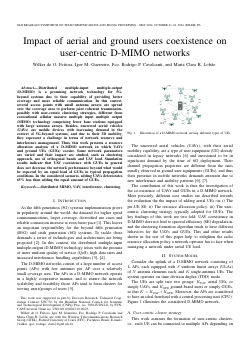
Impact of aerial and ground users coexistence on user-centric D-MIMO networks
Wilker de O Feitosa, Igor M. Guerreiro, Francisco R. P. Cavalcanti, Maria Clara R. Lobão
DOI: 10.14209/sbrt.2024.1571036804
Evento: XLII Simpósio Brasileiro de Telecomunicações e Processamento de Sinais (SBrT2024)
Keywords: distributed MIMO UAV interference clustering
Abstract
Distributed multiple-input multiple-output (D-MIMO) is a promising network technology for 5G-beyond systems due to their capability of providing better coverage and more reliable communication. In this context, several access points with small antenna arrays are spread over the coverage area to perform joint coherent transmission, possibly with user-centric clustering strategies, different from conventional cellular massive multiple input multiple output (MIMO) technology comprising fewer base stations equipped with large antenna arrays. Besides, uncrewed aerial vehicles (UAVs) are mobile devices with increasing demand in the context of 5G-beyond systems, and due to their 3D mobility, they represent a challenge in terms of network resource and interference management. Thus, this work presents a resource allocation analysis of a D-MIMO network in which UAVs and ground UEs (GUEs) coexist. Some network parameters are varied and their impact are studied, such as clustering approach, use of orthogonal bands and UAV load. Simulation results indicate that UAV coexistence with GUEs in general does not decrease the network performance beyond what would be expected by an equal load of GUEs in typical propagation conditions.Download